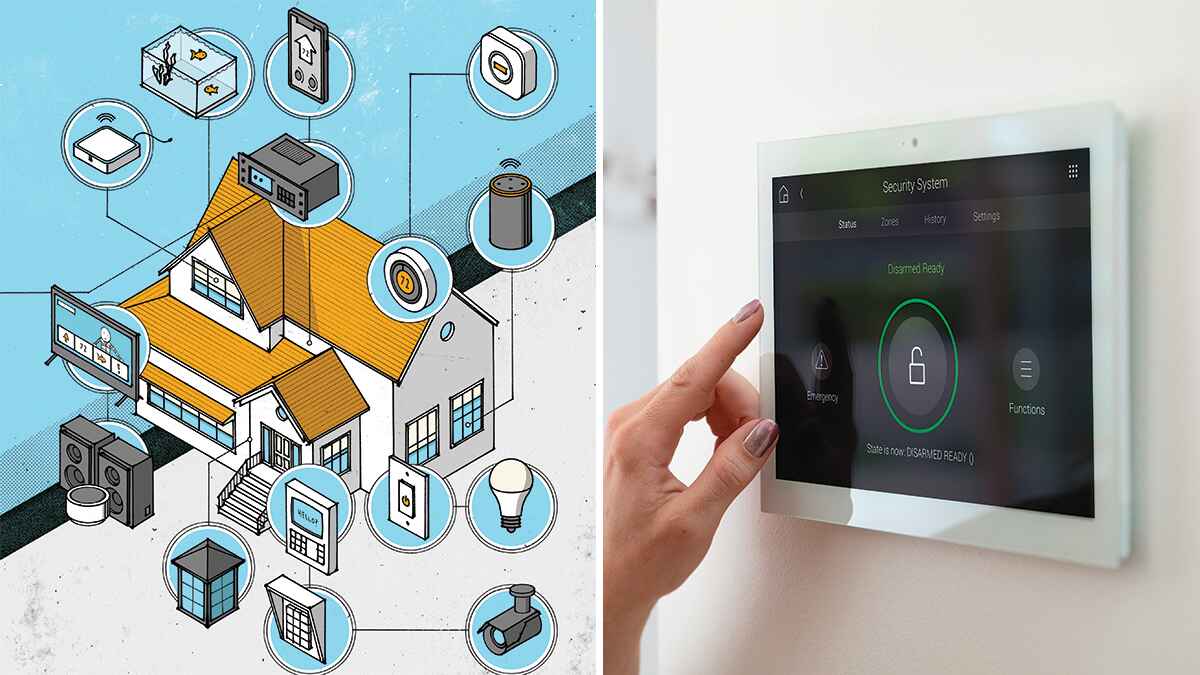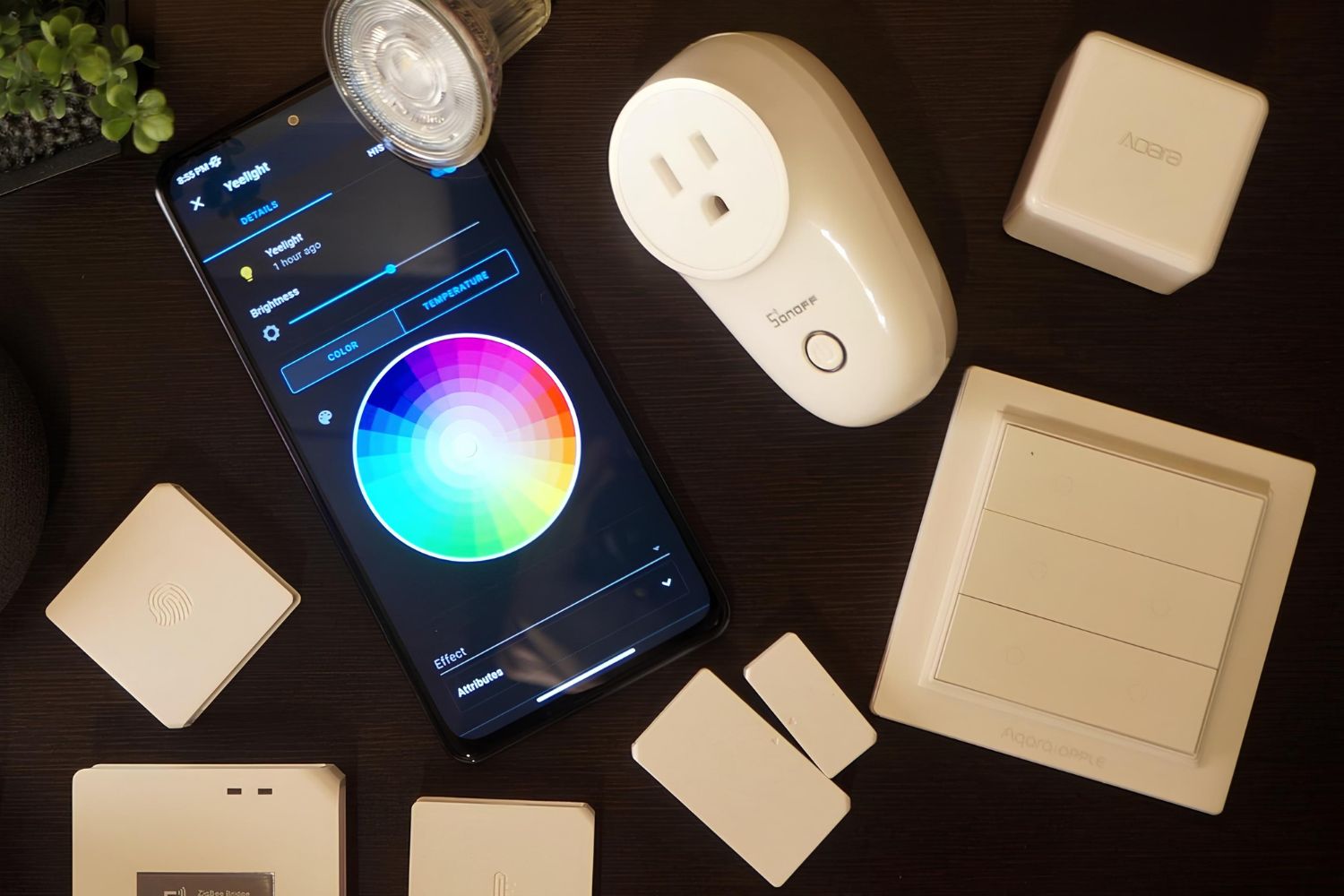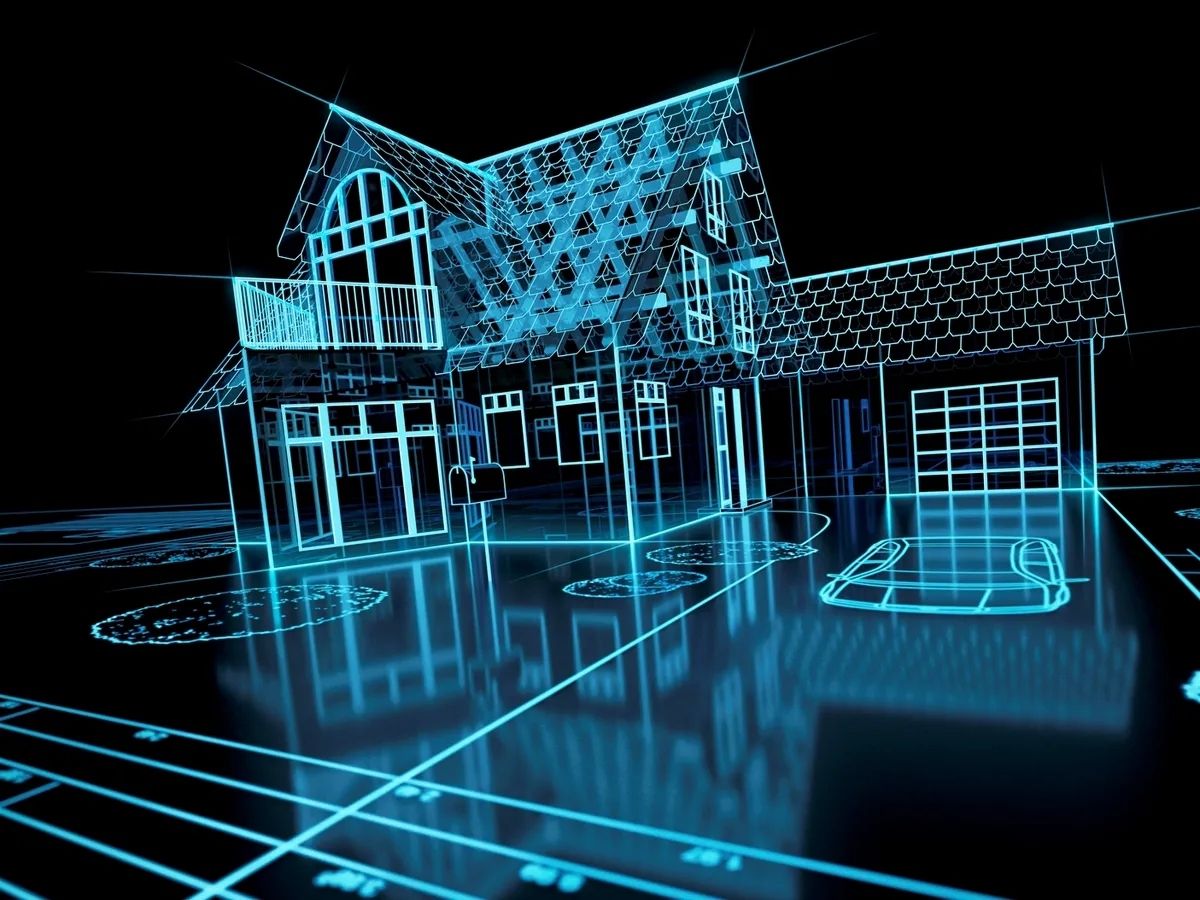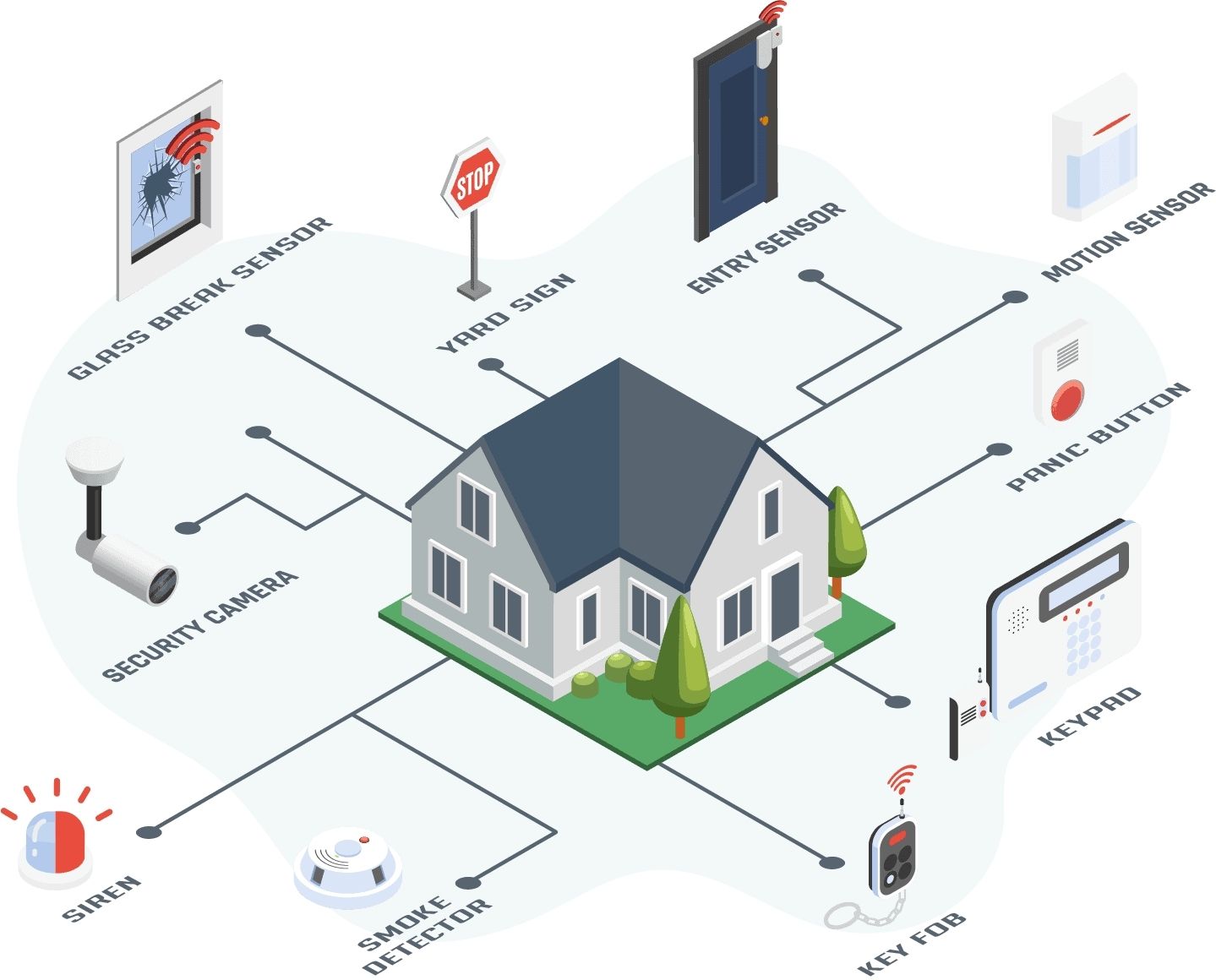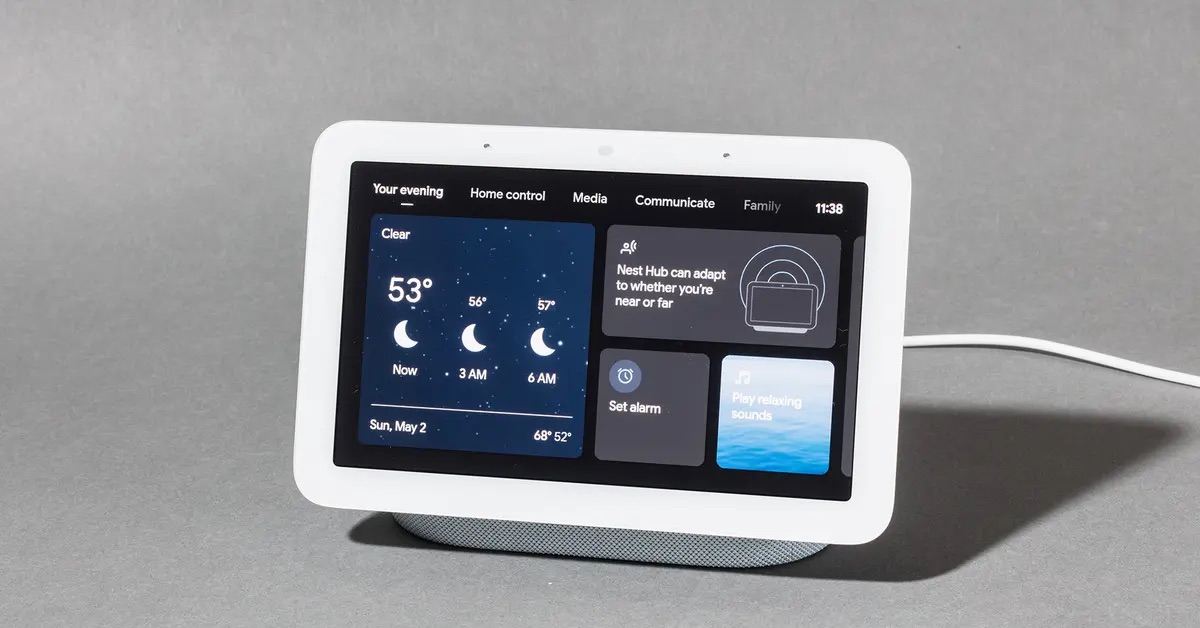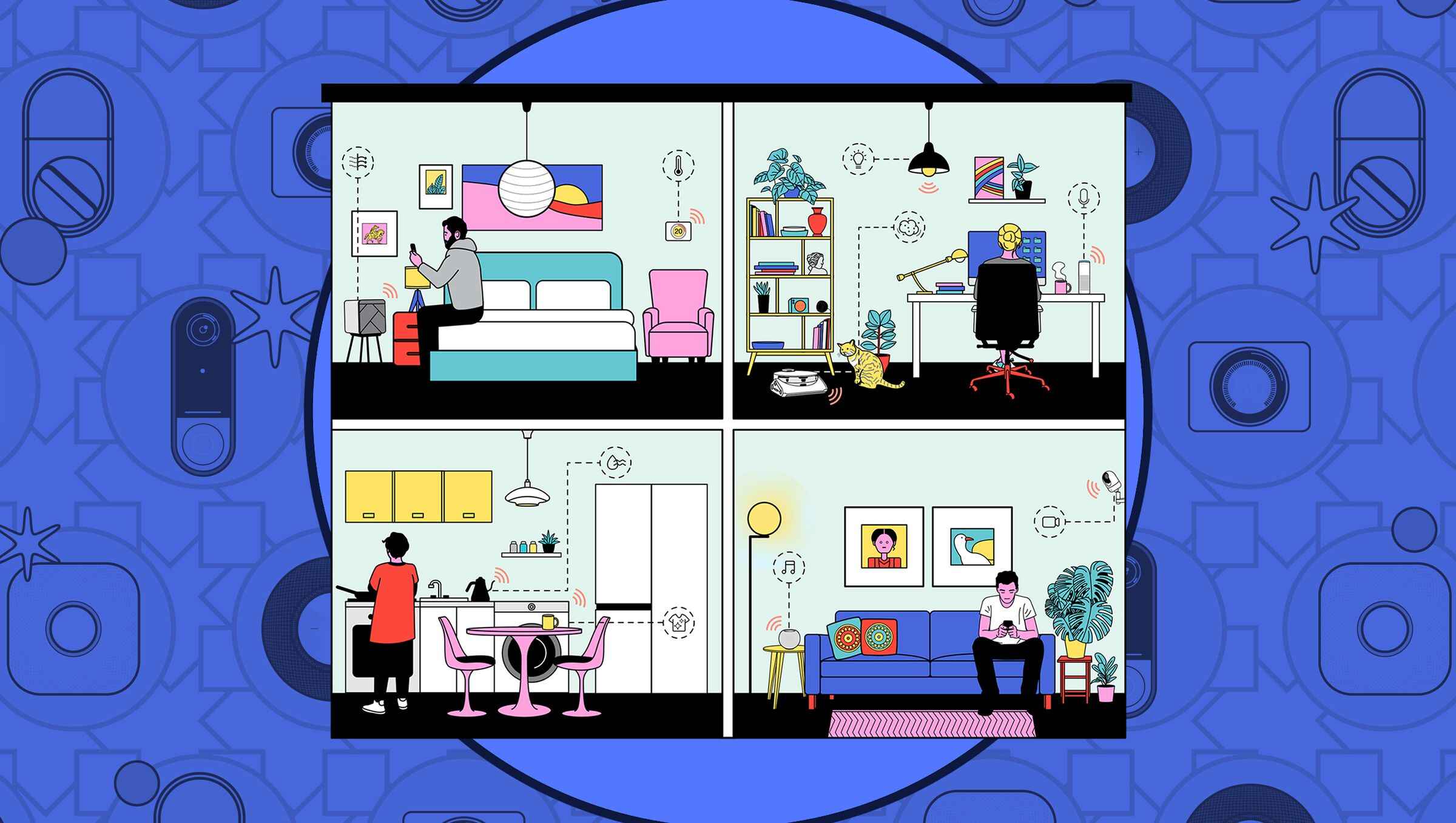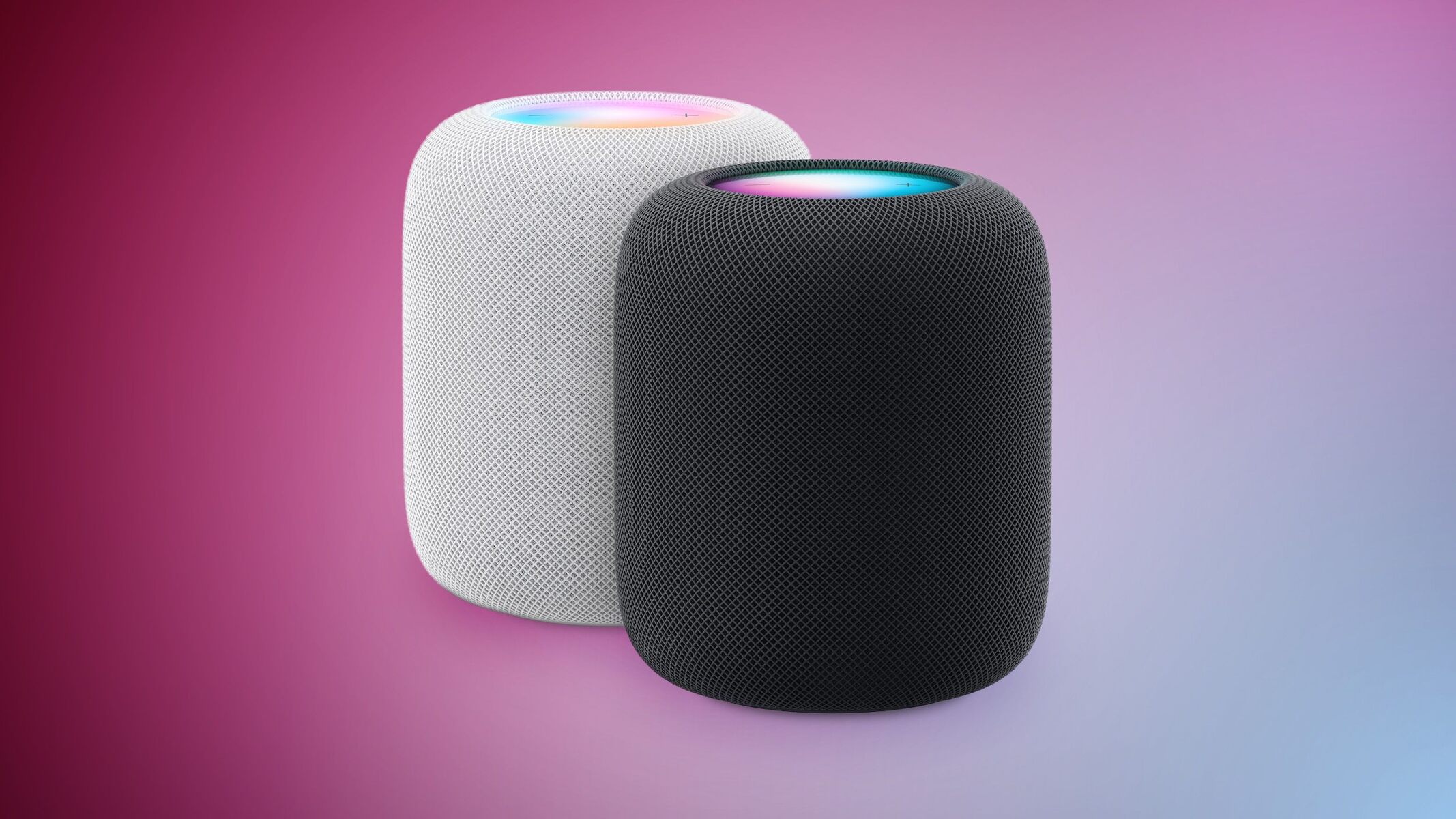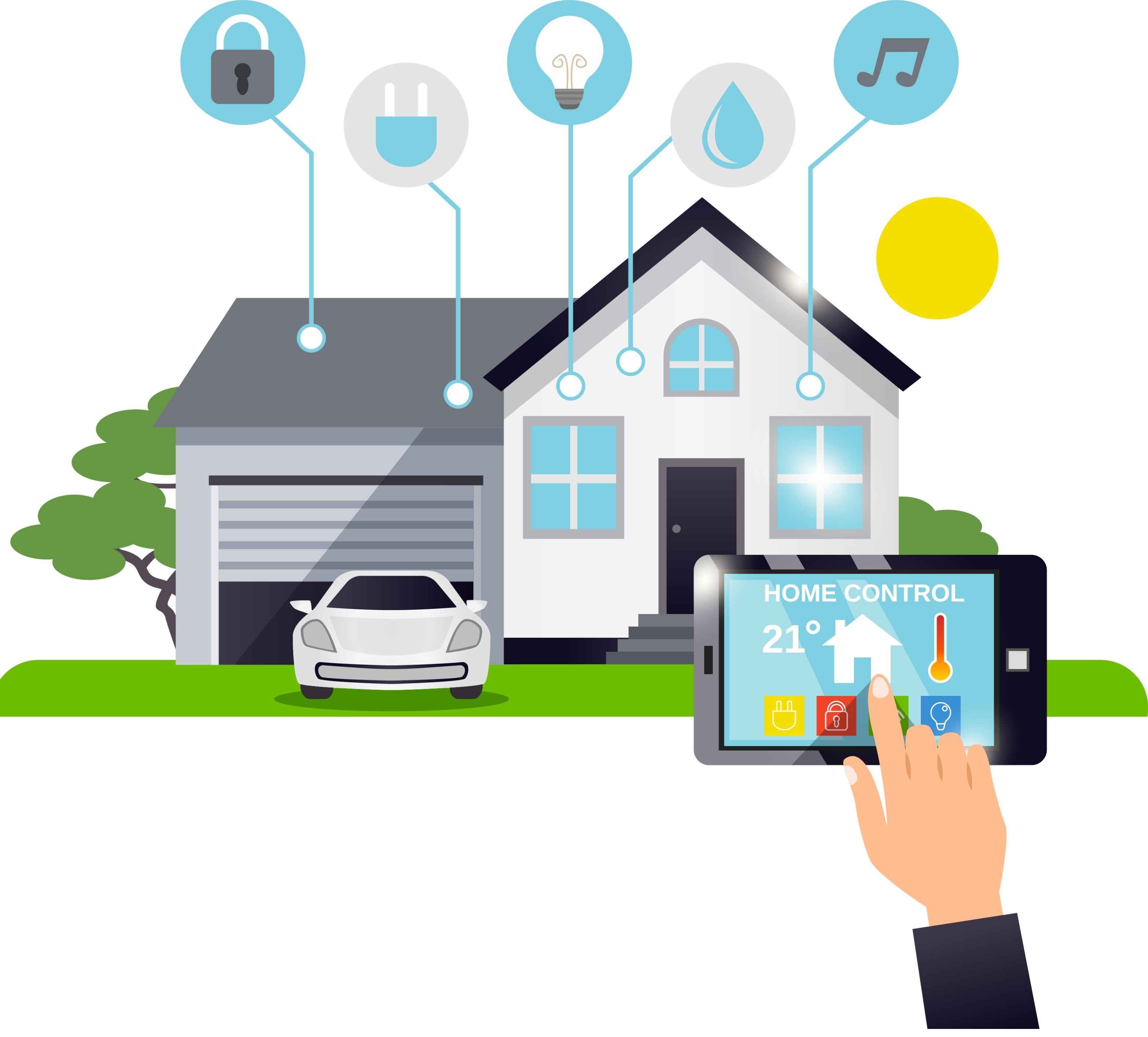Introduction
Welcome to the world of smart home devices, where automation and convenience meet to transform your living space. The integration of various smart home devices allows you to control and monitor your home with just a few taps or even voice commands. From smart thermostats that efficiently manage your energy usage to smart security systems that provide peace of mind, these devices have revolutionized the way we interact with our homes.
Imagine arriving home to a perfectly lit living room and the temperature set to your preferred level, all thanks to the seamless integration of your smart lights and smart thermostats. With a simple command to your smart speaker, you can initiate a series of actions that activate different elements of your smart home ecosystem. The possibilities are endless, and the convenience and efficiency provided by these devices are unmatched.
However, getting all your smart home devices to work together seamlessly can sometimes be a daunting task. Compatibility, setup, and troubleshooting can be tricky, but fear not! In this guide, we will walk you through the necessary steps to integrate and connect all your smart home devices.
Whether you’re starting from scratch or looking to expand your existing smart home setup, this guide will help you navigate the world of smart home integration and ensure that all your devices work harmoniously together. From choosing the right hub to connecting your smart speaker, setting up smart lights, integrating thermostats, linking security systems, and even adding smart appliances, we’ve got you covered.
So, sit back, relax, and let’s embark on a journey to transform your home into a smart home paradise!
Assessing Compatibility and Choosing a Hub
Before diving into the world of smart home devices, it’s crucial to assess the compatibility of the devices you plan to integrate. Not all devices work seamlessly together, so taking the time to research and ensure compatibility will save you time and frustration down the line. Look for devices that are labeled as “works with” compatible with each other, as this indicates that they have been designed to work together.
Once you have a list of compatible devices, it’s time to choose a hub. A hub serves as the central control system for your smart home devices, allowing you to manage and automate them from a single app or interface. There are various options available, including smart speakers with built-in hubs, dedicated hub devices, and even virtual assistants like Amazon Alexa or Google Assistant.
When choosing a hub, consider the following factors:
- Compatibility: Ensure that the hub you choose is compatible with all the devices you plan to integrate into your smart home system. Compatibility lists can usually be found on the manufacturer’s website or product packaging.
- Connectivity: Check if the hub supports the connectivity protocols used by your devices, such as Wi-Fi, Bluetooth, Zigbee, or Z-Wave. Having a hub that supports a wide range of connectivity options gives you the flexibility to connect various devices.
- Scalability: Consider whether the hub supports adding additional devices in the future. As your smart home grows, you may want to add more devices, so having a hub that can handle the expansion is essential.
- Features and Integration: Look for additional features offered by the hub, such as voice control, automation capabilities, and integration with other smart home ecosystems. Having these features can enhance the overall smart home experience and make controlling your devices even easier.
- User-Friendliness: Consider the user interface and ease of use of the hub’s app or interface. A user-friendly interface can make the setup and management of your smart home devices a breeze.
By carefully considering these factors, you can choose the right hub that fits your needs and ensures compatibility with your chosen smart home devices. Once you have selected a hub, it’s time to move on to the next step: connecting your smart speaker.
Connecting your Smart Speaker
Your smart speaker will serve as the voice-controlled hub of your smart home system, allowing you to control other devices with just your voice. Before you begin, make sure your smart speaker is compatible with the devices you want to connect. Most smart speakers, like Amazon Echo or Google Nest, support a wide range of smart home devices.
To connect your smart speaker, follow these steps:
- Place your smart speaker in a central location within your home to ensure optimal coverage for voice commands.
- Download the companion app for your smart speaker from the app store on your smartphone or tablet.
- Follow the instructions in the app to set up your smart speaker. This usually involves connecting the speaker to your Wi-Fi network.
- Once your smart speaker is set up, open the app and navigate to the smart home or connected devices section.
- Select the option to add a new device and choose the specific type of device you want to connect.
- Follow the on-screen instructions to put your device into pairing mode. This typically involves holding down a button or following a specific sequence of button presses.
- Once your device is in pairing mode, the app will search for available devices. When your device appears on the list, select it to initiate the pairing process.
- Once the pairing process is complete, you can assign a name or label to your device for easy identification.
Repeat these steps for each device you want to connect to your smart speaker. Once all your devices are connected, you can control them using voice commands. For example, you can say “Hey Google, turn on the living room lights” or “Alexa, lock the front door.”
Remember to give each device a distinct name to avoid confusion, especially if you have multiple devices of the same type in your home. You can also group devices together to control multiple devices at once. For instance, you can create a group called “Downstairs” to control all the lights and appliances on the first floor of your home.
Connecting your smart speaker is a crucial step in creating a fully integrated smart home system. It allows for convenient and hands-free control of your devices, enhancing the overall smart home experience.
Setting up Smart Lights
Smart lights are one of the most popular and practical smart home devices. They offer convenience, energy efficiency, and the ability to customize lighting according to your preferences. To set up your smart lights, follow these steps:
- Choose the type of smart lights you want to install. Options include smart bulbs, smart switches, or smart light strips.
- If you’re opting for smart bulbs, replace your existing bulbs with the smart bulbs in the desired locations. Ensure that the power to the lights is turned off before replacing the bulbs.
- Download the companion app for your smart lights from the app store on your smartphone or tablet.
- Open the app and create an account if necessary. Follow the on-screen instructions to set up your smart lights.
- Connect the smart lights to your Wi-Fi network. This typically involves inputting your Wi-Fi network name and password into the app.
- Once connected, the app will guide you through the process of naming and grouping your lights. This allows you to control multiple lights simultaneously.
- Explore the app’s features to customize your smart lights. You can set schedules, create lighting scenes, adjust brightness, and even change the color of compatible smart bulbs.
- If you have a compatible smart speaker, integrate your smart lights with it. This allows you to control your lights using voice commands.
- Test your smart lights to ensure they are functioning correctly. Use the app or your smart speaker to turn the lights on and off, adjust their color or brightness, and activate any preset scenes.
Once your smart lights are set up, you can enjoy a whole new level of lighting control. You can create different lighting scenes for various activities, such as “movie night” or “romantic dinner,” and switch between them with a single tap on your smartphone or a voice command to your smart speaker.
Smart lights also offer energy-saving benefits. You can set schedules to turn the lights on and off automatically, saving both electricity and money. Additionally, many smart lights are compatible with home automation systems, allowing you to integrate them with other smart home devices for even more convenience and control.
With smart lights, you have the power to transform your home’s ambiance and create the perfect lighting environment for any occasion.
Integrating Smart Thermostats
Smart thermostats are a game-changer when it comes to managing your home’s heating and cooling. They allow for precise temperature control, energy savings, and remote access. To integrate a smart thermostat into your smart home system, follow these steps:
- Choose a compatible smart thermostat based on your heating and cooling system. Make sure it supports your HVAC system, whether it’s central heating and air conditioning, heat pump, or a different setup.
- Turn off the power to your HVAC system at the circuit breaker before starting the installation process.
- Remove your existing thermostat from the wall and disconnect the wires. Take a picture of the wire connections for reference.
- Follow the manufacturer’s instructions to install and mount the smart thermostat on the wall. Make sure to connect the wires correctly according to the labeled terminals.
- Turn on the power to your HVAC system and follow the thermostat’s on-screen prompts to connect to your home’s Wi-Fi network.
- Download the companion app for your smart thermostat on your smartphone or tablet.
- Open the app and create an account if necessary. Follow the prompts to set up your smart thermostat and connect it to your account.
- Explore the app’s features to customize your thermostat settings. You can set schedules, adjust temperature presets, and even control the thermostat remotely.
- If you have a compatible smart speaker or hub, integrate your smart thermostat with it. This allows you to control your thermostat using voice commands or through a centralized smart home interface.
- Test your smart thermostat by adjusting the temperature settings using both the app and your voice commands.
Once your smart thermostat is integrated into your smart home system, you can enjoy the benefits of improved energy efficiency and thermostat control. Smart thermostats often have advanced features like learning algorithms that analyze your heating and cooling patterns, helping to optimize energy usage while keeping your home comfortable.
Remote access to your thermostat allows you to adjust the temperature while you’re away, ensuring that you arrive home to a comfortable environment while minimizing unnecessary energy consumption. Some smart thermostats can even provide energy usage reports, helping you track and manage your home’s energy efficiency.
Integrating a smart thermostat into your smart home system is an excellent way to enhance comfort, save energy, and take control of your home’s heating and cooling.
Linking Smart Home Security Systems
Smart home security systems offer enhanced protection for your home, allowing you to monitor and control various aspects of your security setup remotely. Integrating your smart home security system with other devices in your smart home ecosystem is essential to maximize its functionality. Here’s how you can link your smart home security systems:
- Choose a smart home security system that suits your needs. This can include features such as security cameras, door/window sensors, motion detectors, and even smart locks.
- Install and set up your smart home security devices according to the manufacturer’s instructions. Place security cameras in strategic locations, install motion detectors in key areas, and place door/window sensors on vulnerable entry points.
- Download the companion app for your smart home security system on your smartphone or tablet.
- Create an account if necessary and follow the prompts to connect your security devices to your network.
- From the app, you can personalize your security settings, such as setting up notifications for motion detection or door/window disturbances.
- If you have a smart hub or a virtual assistant like Amazon Alexa or Google Assistant, integrate your security system with it. This allows you to control your security devices through voice commands or a centralized interface.
- Explore additional features offered by your security system, such as remote viewing or two-way audio capabilities for security cameras.
- Test your security system by arming and disarming it through the app or your voice commands. Check if the motion detectors, door/window sensors, and other components are working correctly.
Once your smart home security system is linked to your smart home ecosystem, you can enjoy the peace of mind that comes with advanced security features. You can receive instant notifications on your smartphone if there is any suspicious activity or a breach in security.
Integration with other smart home devices allows for enhanced security automation. For example, you can set up “scenes” that automatically turn on your outdoor lights and lock your doors when the security system is armed at night.
In addition, remote access to your security system lets you monitor your home from anywhere, so you can double-check that all is well even when you’re away.
Linking your smart home security system to your smart home devices is an invaluable step in creating a comprehensive and proactive home security solution.
Adding Smart Appliances
Smart appliances offer convenience and efficiency, allowing you to control and monitor your household tasks with ease. Integrating smart appliances into your smart home system expands your control and automation capabilities. Here’s how you can add smart appliances to your smart home:
- Choose the smart appliances that align with your needs and preferences. Common smart appliances include refrigerators, ovens, washing machines, and dishwashers.
- Install and set up your smart appliances according to the manufacturer’s instructions. This may involve connecting them to your Wi-Fi network or other home automation systems.
- Download the companion app for each smart appliance on your smartphone or tablet.
- Create an account if needed and follow the prompts to connect your smart appliances to your network.
- From the app, you can access various features specific to each appliance. For example, you can adjust the temperature of your smart refrigerator or monitor the progress of your smart washing machine.
- If you have a smart hub or virtual assistant, integrate your smart appliances with it. This allows you to control and manage multiple appliances through voice commands or a centralized interface.
- Explore additional features offered by your smart appliances. Some appliances can suggest recipes based on the items in your smart refrigerator, while others can provide energy usage reports or run diagnostics to identify any issues.
- Test each smart appliance to ensure they are functioning correctly. Use the app or your voice commands to perform tasks such as preheating the smart oven or starting a load of laundry in the smart washing machine.
Integrating smart appliances into your smart home system revolutionizes household tasks. With remote access and control, you can monitor and manage your appliances even when you’re not at home. For example, you can receive notifications when your laundry is done or adjust the temperature of your oven from your smartphone.
Automation capabilities allow for a seamless experience. You can set up routines that turn on your coffee maker in the morning or activate your dishwasher at a specific time, saving you time and effort.
In addition, smart appliances can provide valuable insights and analytics. Energy usage reports help you track your consumption and make more eco-friendly choices, while diagnostics can identify any potential issues with your appliances before they become major problems.
Adding smart appliances to your smart home system brings convenience, efficiency, and an elevated level of control to your daily tasks.
Controlling Smart Blinds and Curtains
Smart blinds and curtains offer convenience, privacy, and energy savings by allowing you to control the amount of light and heat that enters your home. Integrating these smart window treatments into your smart home system enhances their functionality and enables automated control. Here’s how you can control your smart blinds and curtains:
- Select the type of smart blinds or curtains that suit your needs. Options include motorized blinds, curtains with smart tracks, or retrofit kits that convert existing blinds into smart blinds.
- Install the smart blinds or curtain system according to the manufacturer’s instructions. This may involve mounting hardware, connecting power sources, or programming the system.
- Download the companion app for your smart blinds or curtains on your smartphone or tablet.
- Open the app and create an account if necessary. Follow the prompts to connect your smart blinds or curtains to your network.
- Assign a name to each blind or curtain for easy identification.
- Explore the app’s features to control your smart blinds or curtains. This may include adjusting the position or angle of the blinds, setting schedules for automatic opening and closing, or creating scenes that coordinate with your daily routine.
- If you have a smart hub or virtual assistant, integrate your smart blinds or curtains with it. This allows you to control your window treatments through voice commands or a centralized smart home interface.
- Test the control functions from the app or using voice commands to ensure that your smart blinds or curtains respond as intended.
Controlling your smart blinds or curtains brings a new level of convenience and customization to your home. With simple taps on your smartphone or voice commands, you can effortlessly adjust the lighting and privacy of any room.
Automating your window treatments allows for hands-free operation and energy efficiency. You can set schedules to open or close the blinds at specific times of the day, optimizing natural lighting and reducing the use of artificial lighting. Additionally, integrating your smart blinds or curtains with other smart devices can create seamless automation scenarios. For example, you can configure your blinds or curtains to open when your morning alarm goes off or close when you activate the “goodnight” scene in your smart home system.
Remote access enables you to control your blinds or curtains from anywhere, providing an added layer of security by giving the illusion of an occupied home, even when you’re away.
Controlling your smart blinds or curtains is not only about convenience but also about creating a more comfortable and efficient living environment.
Managing Smart Home Entertainment
Smart home entertainment systems bring a whole new level of immersive and personalized entertainment to your living space. You can seamlessly control and manage your audiovisual devices, creating a truly captivating home entertainment experience. Here’s how you can manage your smart home entertainment:
- Choose the audiovisual devices for your smart home entertainment system, such as smart TVs, streaming devices, soundbars, or speakers.
- Set up and connect your devices according to the manufacturer’s instructions. This may involve connecting them to your Wi-Fi network, configuring sound settings, or accessing streaming platforms.
- Download the companion app for each device on your smartphone or tablet.
- Create accounts if necessary and follow the prompts to connect your devices to your network.
- Explore the features of each app to control and manage your smart home entertainment. This can include adjusting volume, selecting content from streaming platforms, customizing sound settings, or creating playlists.
- If you have a smart hub or virtual assistant, integrate your smart home entertainment devices with it. This allows you to control them through voice commands or a centralized smart home interface.
- Explore additional features offered by your devices and apps, such as multi-room audio or casting capabilities.
- Test the control functions from the app or using voice commands to ensure that your smart home entertainment devices respond as intended.
Managing your smart home entertainment allows for a personalized and convenient entertainment experience. With a single app or voice command, you can control all aspects of your audiovisual setup.
Customization and personalization options are abundant. You can create favorite lists, tailor sound settings to your preferences, and access a wide range of streaming platforms and content libraries. Additionally, integrating your smart home entertainment devices with other smart devices can enhance your overall entertainment setup. For example, you can configure your smart lights to dim or change colors automatically when you start watching a movie, or your smart blinds to close for the optimal viewing experience.
With remote access, you can control your smart home entertainment system from anywhere. Start playing music as you walk through the front door, queue up your favorite show while you’re away, or adjust the volume without leaving the comfort of your seat.
Managing your smart home entertainment system brings convenience, customization, and an immersive entertainment experience right into your living room.
Troubleshooting Integration Issues
While connecting and integrating smart home devices can greatly enhance your living experience, it is common to encounter issues along the way. Troubleshooting integration issues is essential to ensure that all your devices work together seamlessly. Here are some common integration issues and troubleshooting steps:
- Device Not Connecting: If a device is not connecting to your network or hub, check the device’s power source and make sure it is in range of your Wi-Fi or hub. Restart the device and ensure that you follow the setup instructions carefully.
- Incompatibility: If devices are not working together as expected, confirm that they are compatible with each other and with your hub or virtual assistant. Check the compatibility lists provided by the manufacturers and ensure that all devices are using the same communication protocols (e.g., Wi-Fi, Zigbee, Z-Wave).
- Weak Signal Strength: If you experience weak signal strength or devices frequently disconnecting, consider improving your Wi-Fi coverage. You can try moving your router to a more central location, adding Wi-Fi extenders, or upgrading to a mesh Wi-Fi system for better coverage throughout your home.
- Software Updates: Keep your devices and smart home system apps up to date with the latest firmware or software updates. Manufacturers often release updates to address bugs, improve compatibility, or introduce new features.
- Conflicting Settings: Check the settings of your devices and apps to ensure they are not conflicting with each other. For example, ensure that there are no duplicate scenes or routines that trigger conflicting actions.
- Resetting Devices: If all else fails, try resetting the problematic device to its factory default settings and set it up again. This can help resolve any software glitches or configuration issues.
- Contact Support: If you have exhausted all troubleshooting steps and the issue persists, reach out to the manufacturer’s customer support for further assistance. They may have specific troubleshooting steps or firmware updates to address known issues.
Remember to be patient and persistent when troubleshooting integration issues. It may take some trial and error to identify and resolve the root cause of the problem. Keeping documentation of your setup, including device names, models, and configurations, can be helpful when seeking support.
By following these troubleshooting steps and seeking assistance when needed, you can overcome integration issues and create a fully functional and integrated smart home system.
Conclusion
Congratulations! By following this guide, you have learned how to integrate all your smart home devices into a seamless and efficient system. From assessing compatibility and choosing a hub to connecting smart speakers, setting up smart lights, integrating thermostats, linking security systems, adding smart appliances, controlling smart blinds and curtains, managing smart home entertainment, and troubleshooting integration issues, you now have the knowledge and tools to enjoy the full potential of your smart home.
The integration of smart home devices offers a multitude of benefits, including convenience, energy savings, enhanced security, and personalized experiences. With the ability to control and monitor your devices remotely, automate routines, and customize settings, your smart home becomes a personalized ecosystem that caters to your needs and preferences.
Remember to regularly update and maintain your smart home devices and systems to ensure optimal performance. Keep an eye out for new features, firmware updates, and compatibility improvements that manufacturers may release over time. Additionally, stay informed about emerging technology trends in the smart home industry to explore new possibilities and innovations for your home.
Creating a smart home is an ongoing process. As technology advances and new devices enter the market, you can continue to expand and enhance your smart home ecosystem. Whether it’s integrating voice assistants, adding smart cameras for enhanced security, or exploring the possibilities of smart home automation, the possibilities are endless.
Enjoy the convenience, comfort, and efficiency that your integrated smart home brings, and embrace the exciting possibilities that lie ahead in the world of smart home technology!







